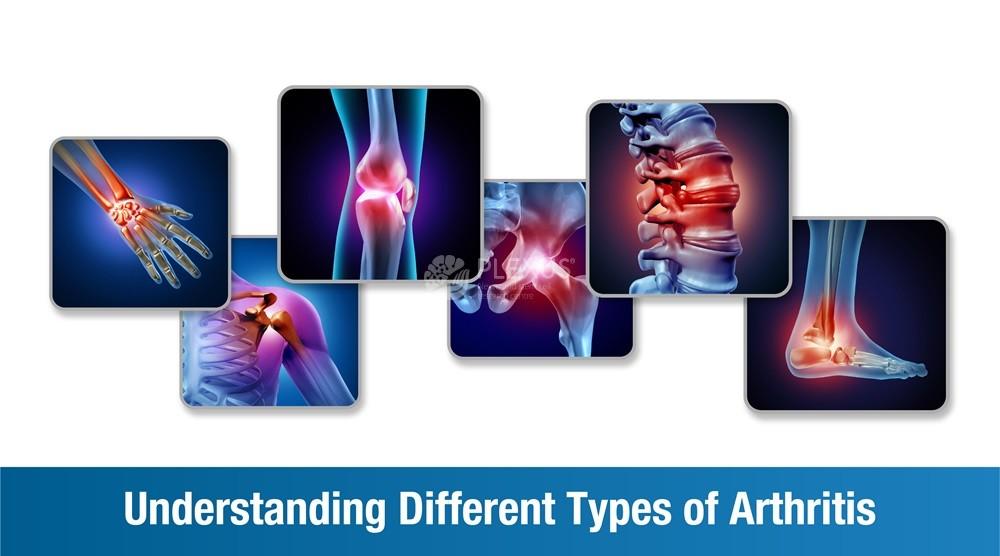
Arthritis is more than just a medical condition, it is a journey marked by pain, inflammation, and reduced mobility. Did you know there are over 100 identified types of arthritis? In this blog, we will delve into the most common types of arthritis, specifically focusing on the types that affect the hands, knees, fingers, shoulder, and lower back.
Types of Arthritis
Osteoarthritis (OA)
This is the most common type of arthritis, and occurs when the protective cartilage that cushions the ends of bones wears down over time. It is an inflammatory and degenerative disease that can lead to almost complete deterioration of the joints. OA can impact any joint but is most often found in the knees, hips, hands, and spine.
Common symptoms of osteoarthritis include muscle weakness, joint deformities and enlargement, formation of bone spurs, limited range of motion, stiffness, swelling, grating or grinding within the joint during movement, etc.
Rheumatoid Arthritis (RA)
A chronic autoimmune disorder, RA is characterised by the immune system mistakenly attacking the synovium, the lining of the membranes that surround the joints. This can lead to inflammation and joint damage. As the disease advances, the inflammation spreads to other organs, leading to systemic complications.
Common symptoms of rheumatoid arthritis include joint pain, stiffness, swelling, as well as fatigue.
Psoriatic Arthritis (PsA)
Associated with the skin condition psoriasis, PsA affects both the skin and joints. It can cause joint pain, stiffness, and swelling, often affecting the fingers, toes, wrists, knees, and ankles.
Other symptoms of psoriatic arthritis include stiffness, joint pain, red and scaly symptoms, nail changes (pitting, thickening, separation from the nail bed), vision changes, enthesitis (inflammation at the site of tendon or ligament), dactylitis (swelling of whole fingers or toes), reduced range of motion, etc.
Read more about autoimmune conditions and their treatment program at Plexus here.
Ankylosing Spondylitis (AS)
AS primarily affects the spine, causing inflammation and potentially leading to the fusion of vertebrae. This can result in a hunched-forward posture and limited mobility.
Common symptoms of ankylosing spondylitis include back pain, neck pain, stiffness, fatigue, pain in other joints (shoulders, knees, ankles), enthesitis, unintended weight loss, reduced mobility, etc.
Gout
Gout is characterized by the buildup of uric acid crystals in the joints, leading to sudden and severe joint pain, swelling, and redness. The big toe is a commonly affected area.
Common symptoms of gout include intense joint pain, inflammation and swelling, warmth and redness around the area of inflammation, limited range of motion, fever, nighttime pain, etc.
Juvenile Idiopathic Arthritis (JIA)
Formerly known as juvenile rheumatoid arthritis, JIA is a group of chronic arthritis conditions affecting children under the age of 16. It includes various subtypes, each with distinct features.
Common symptoms of juvenile idiopathic arthritis are joint pain and stiffness, warmth and redness around the area of inflammation, fatigue, fever, rash, eye inflammation, etc.
Lupus-Associated Arthritis
Lupus is an autoimmune disease that can cause arthritis as one of its symptoms. The joints, skin, kidneys, blood cells, brain, heart, and lungs can be affected.
Common symptoms of lupus-associated arthritis include morning stiffness, photosensitivity, fatigue, fever, hair loss, oral or nasal ulcers, inflammation in kidneys, skin rashes, joint pain and swelling, etc.
Reactive Arthritis
Reactive arthritis, also known as Reiter’s syndrome, can develop in response to an infection in another part of the body. It often affects the joints, eyes, and urinary and genital systems.
Common symptoms of reactive arthritis are back pain, joint pain and swelling, conjunctivitis, enthesitis, fever, mouth ulcers, urethritis (inflammation of the urethra),fatigue, fever, etc.
Septic Arthritis
Caused by an infection in the joint, septic arthritis can lead to severe pain, swelling, and redness. Prompt medical attention is crucial to prevent joint damage.
Common symptoms of septic arthritis include fever, joint pain and swelling, warmth and redness around the area of inflammation, localized tenderness, joint effusion (accumulation of fluid in the joints), increased pain with movement, etc.
Whether it is the common osteoarthritis and rheumatoid arthritis or the rare juvenile idiopathic arthritis, each type of arthritis requires a tailored approach to treatment. Plexus provides customized regenerative rehabilitation programs at our centres in Bangalore and Hyderabad.
Read about Plexus’ stem cell rehabilitation for arthritis here.
FAQs
How serious is rheumatoid arthritis?
Rheumatoid arthritis is a chronic autoimmune disorder that leads to joint damage, deformities, and impact overall health. It requires consistent comprehensive management, including medications and lifestyle changes, to control symptoms and prevent progression.
What is the most painful type of arthritis?
Gout is often regarded as the most painful type of arthritis. It is characterized by the sudden onset of severe pain, swelling, and tenderness, commonly affecting the big toe.
What is the main cause of arthritis?
Age, genetics, and joint injuries are among the main causes and risk factors of arthritis. Osteoarthritis is also often associated with wear and tear on joint cartilage over time.
What foods are good for arthritis?
Foods rich in omega-3 fatty acids, antioxidants, and anti-inflammatory spices (such as turmeric) can benefit arthritis patients.
What is the end stage of arthritis?
The end stage of arthritis typically involves severe joint damage, deformities, and loss of function. In severe cases, joint replacement surgery is recommended.










